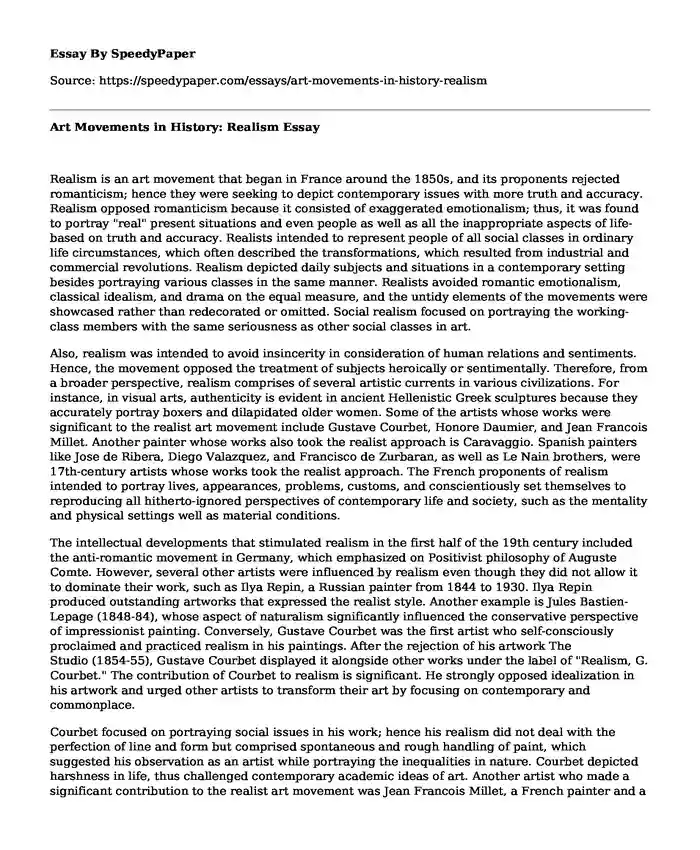
| Type of paper: | Essay |
| Categories: | Culture Government Justice |
| Pages: | 4 |
| Wordcount: | 829 words |
Realism is an art movement that began in France around the 1850s, and its proponents rejected romanticism; hence they were seeking to depict contemporary issues with more truth and accuracy. Realism opposed romanticism because it consisted of exaggerated emotionalism; thus, it was found to portray "real" present situations and even people as well as all the inappropriate aspects of life-based on truth and accuracy. Realists intended to represent people of all social classes in ordinary life circumstances, which often described the transformations, which resulted from industrial and commercial revolutions. Realism depicted daily subjects and situations in a contemporary setting besides portraying various classes in the same manner. Realists avoided romantic emotionalism, classical idealism, and drama on the equal measure, and the untidy elements of the movements were showcased rather than redecorated or omitted. Social realism focused on portraying the working-class members with the same seriousness as other social classes in art.
Also, realism was intended to avoid insincerity in consideration of human relations and sentiments. Hence, the movement opposed the treatment of subjects heroically or sentimentally. Therefore, from a broader perspective, realism comprises of several artistic currents in various civilizations. For instance, in visual arts, authenticity is evident in ancient Hellenistic Greek sculptures because they accurately portray boxers and dilapidated older women. Some of the artists whose works were significant to the realist art movement include Gustave Courbet, Honore Daumier, and Jean Francois Millet. Another painter whose works also took the realist approach is Caravaggio. Spanish painters like Jose de Ribera, Diego Valazquez, and Francisco de Zurbaran, as well as Le Nain brothers, were 17th-century artists whose works took the realist approach. The French proponents of realism intended to portray lives, appearances, problems, customs, and conscientiously set themselves to reproducing all hitherto-ignored perspectives of contemporary life and society, such as the mentality and physical settings well as material conditions.
The intellectual developments that stimulated realism in the first half of the 19th century included the anti-romantic movement in Germany, which emphasized on Positivist philosophy of Auguste Comte. However, several other artists were influenced by realism even though they did not allow it to dominate their work, such as Ilya Repin, a Russian painter from 1844 to 1930. Ilya Repin produced outstanding artworks that expressed the realist style. Another example is Jules Bastien-Lepage (1848-84), whose aspect of naturalism significantly influenced the conservative perspective of impressionist painting. Conversely, Gustave Courbet was the first artist who self-consciously proclaimed and practiced realism in his paintings. After the rejection of his artwork The Studio (1854-55), Gustave Courbet displayed it alongside other works under the label of "Realism, G. Courbet." The contribution of Courbet to realism is significant. He strongly opposed idealization in his artwork and urged other artists to transform their art by focusing on contemporary and commonplace.
Courbet focused on portraying social issues in his work; hence his realism did not deal with the perfection of line and form but comprised spontaneous and rough handling of paint, which suggested his observation as an artist while portraying the inequalities in nature. Courbet depicted harshness in life, thus challenged contemporary academic ideas of art. Another artist who made a significant contribution to the realist art movement was Jean Francois Millet, a French painter and a founder of the Barbizon School in the suburbs of France. Millet was recognized as a famous realism painter because most of his work focused on portraying people of low social class, such as his peasant farmers' scenes. However, one of Millet's famous paintings is the Gleaners (1857), which portray women and children of the low social class collecting bits of grain that were left in the fields after harvest.
Title: Gleaners (1857)
Artist: Jean-Francois Millet
Formal Analysis
The Gleaners (1857) portrays three peasant women collecting stray grains of wheat after the harvest. It is famous among the realist paintings because of its sympathetic depiction of the lowest ranks of the rural society, even though members of the French upper class inappropriately perceived it. Millet used the device to imbue his subjects with a simple monumental grandeur and portrays the burdensome nature of their work by using set expressions and thick, substantial features. The figures of women in the foreground are also bent double and appear to be toiling in the darkened front, which is set against a warm pastoral background scene of harvesters who seem to be reaping plentiful harvest evident by the haystacks, cart and the sheaves of wheat. The painting uses the contrast between abundance and scarcity and that between light and shadow to emphasize the class divide. Therefore, the whole composition is a commentary on France's social classes, especially the incapacity of the lower levels to rise above their standard. The foreman on the hose on the remote right together with the peasant farmers watched over by the foreman, and the three men are also evident in the social differences. Therefore, The Gleaners is an example of realism painting in the way it portrays real contemporary situations and people based on truth and accuracy.
Cite this page
Art Movements in History: Realism. (2023, Nov 08). Retrieved from https://speedypaper.com/essays/art-movements-in-history-realism
Request Removal
If you are the original author of this essay and no longer wish to have it published on the SpeedyPaper website, please click below to request its removal:
- Free Essay: How Corporate Governance Is Implemented in the UK
- Life Is Unfair - Free Essay on Capitalism
- Tax Evasion in Oman, Essay Example for Everyone
- Cultural Diversity and Business Environment - Discussion Paper Example
- Essay Example. Rights and Responsibilities of Citizens
- Free Essay Sample on Florida Law on Domestic Abuse
- Essay Sample on Democratic Leadership: Mrs. Cameron, an Effective Nursing Manager
Popular categories




